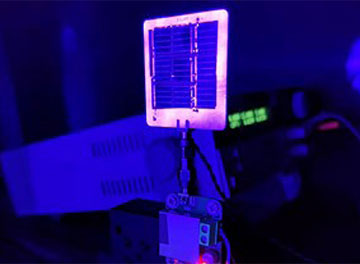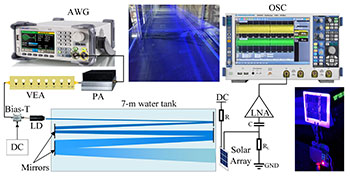
Using a 3×3 array of solar cells as a detector, researchers optimized the design for a low-energy, high-speed underwater wireless optical communication system. [Image: Jing Xu, Zhejiang University, China]
Researchers in China demonstrated a new method for using off-the-shelf solar cells for high-speed underwater wireless optical communication (UWOC). By adding a reverse-bias voltage to a 3×3 series-connected array of solar cells in photoconductive mode, they achieved a data rate of 150 Mbps over 35 meters underwater (Opt. Lett., doi: 10.1364/OL.449466).
“There is a critical need for efficient underwater communication to meet the increasing demands of underwater data exchange in worldwide ocean protection activities,” said team lead Jing Xu, Zhejiang University, China, in a press release.
In addition to high-speed data exchange for ocean conservation applications, the UWOC system could also serve simultaneously as a power source and a lower-speed communication system when the solar cells are switched to photovoltaic mode.
Increasing detection area and maximizing bandwidth
In laboratories, researchers have recorded photodiode-based UWOC speeds up to several Gbps over hundreds of meters. However, these systems would not work in an actual body of water because the strict alignment required to keep the optical signal traveling between the transmitter and detector is nearly impossible to achieve. By using solar cells, Xu’s team created a much larger target for the optical signal, allowing for less rigid alignment between transmitter and receiver: Their 3×3 solar-cell array produced a signal detection area of 3.4 cm2.
Because solar cells are designed to harvest energy, they do not transmit data as efficiently as photodiodes. The researchers boosted their system’s bandwidth by connecting nine monocrystalline solar cells in a series to flatten the frequency response. To further extend the system’s bandwidth, they applied a 90-V reverse-bias voltage to the array and used a low-noise amplifier with high-input resistance to strengthen the optical signal.
Experimental setup and demonstration
The researchers tested a detector made from a 3×3 solar array in a 7-meter-long water tank that emulated an underwater channel. Mirrors were used to extend the pathlength of the optical signal. [Image: Jing Xu, Zhejiang University, China] [Enlarge image]
The experimental setup for the solar-array-equipped UWOC system started with a simple computer-generated on-off keying (OOK) signal that was ultimately combined with a direct current to produce an optical signal. Next, the optical signal, measuring 27.5 dBm, was passed through a 7-meter-long tank filled with tap water and outfitted with four mirrors—two on each end. The signal covered a transmission distance of 35 meters through the water before reaching the 3×3 solar-cell-array detector. After entering the detector, the signal was picked up by an oscilloscope and processed offline.
The fastest data rate the researchers recorded during their underwater demonstrations was 150 Mbps over 35 meters. “To the best of our knowledge,” said the authors in their Optics Letters article, “[this] is the highest bandwidth achieved among the reported solar panel-based optical communication systems with a large detection area.”
Next, the researchers plan to further optimize the UWOC system’s design and test its performance with weak optical signals to see how well it works in cloudy, moving water.

